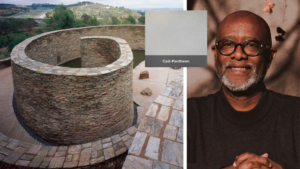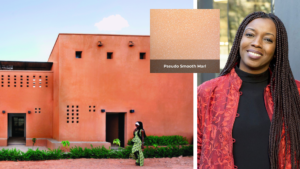Exploring African Descendant Architects’ Contributions to Modern Architecture
August holds a distinct significance within the realm of Portalais, bearing significance for two compelling reasons. Beyond marking a tribute to the rich heritage of African descendants, a perpetual reminder of the industry’s most illustrious architects, it also ushers in the dawn of extraordinary collaboration. This month heralds the launch of an eagerly anticipated partnership between Panda Windows & Doors and Axolotl, a paramount force in the domain of surface manufacturing. Together, they unveil an unparalleled array of exquisite finishes that are set to captivate the world.
Axolotl’s eminence as the foremost purveyor of surface marvels brings forth an eclectic fusion of possibilities, tailored to gratify the discerning tastes of architects, designers, and builders alike. Their repertoire encompasses a diverse panorama of authentic surfaces, ranging from the resplendent allure of metal to the timeless charm of concrete and the earthy elegance of terracotta.
Drawing inspiration from the transcendent feats of visionary architects, we embarked on an imaginative journey, artfully aligning their masterpieces with the avant-garde Panda x Axolotl new finishes. The culmination of this artistic exploration unveils a tapestry of synergies, seamlessly weaving the legacies of architectural brilliance with the innovation of contemporary surface design. Allow us to unveil the culmination of this harmonious fusion—a revelation of unmatched finesse and ingenuity.
David Adjaye (1966 – present)
David Adjaye is a Ghanaian-British architect known for his innovative and socially-conscious designs. He established Adjaye Associates in 2000, and since then, he has gained international recognition for his diverse range of projects. One of his notable works is the Smithsonian National Museum of African American History and Culture in Washington, D.C., completed in 2016. The museum’s design is a powerful representation of African culture and history, featuring a striking bronze-colored facade inspired by the intricate ironwork created by enslaved African Americans in the Southern United States.
We couldn’t pass the opportunity of pairing David’s Ruby City with the Cast Iron Wheatered Rust finish.

Ruby City stands as an architectural gem in San Antonio, Texas. Completed in 2019, this contemporary art center features a bold geometric form clad in crimson-colored precast concrete, a nod to its founder, the late Linda Pace. Ruby City harmoniously marries art and architecture, providing a captivating space for artistic exploration and expression.
Diébédo Francis Kéré (1965 – present)
Diébédo Francis Kéré, hailing from Burkina Faso, is a renowned architect dedicated to sustainable and community-focused architecture. His works often incorporate local materials and traditional building techniques, ensuring his designs are ecologically responsible and culturally relevant. Kéré gained international acclaim for his design of the Serpentine Pavilion in London in 2017, which showcased a visually striking structure made of wooden blocks, creating an inviting gathering space that reflected his commitment to inclusivity and natural beauty.
If you are familiar with the stunning Serpentine Pavilion, you’ll agree that Doric Anthra Zinc has a similar feel to Diébédo’s project.

Diébédo Francis Kéré’s Serpentine Pavilion exudes an organic and earthy aesthetic that reflects his commitment to sustainable architecture and community engagement. The pavilion’s wooden blocks, made from sustainably sourced materials, are stacked in an intricate, undulating pattern, creating a visually captivating and dynamic structure. The design’s openness and lack of barriers invite visitors to gather and interact, fostering a sense of togetherness and inclusivity. This architecture harmonizes with its natural surroundings, connecting people with nature while offering a space for cultural events and discussions.
Mphethi Morojele (1974 – present)
Mphethi Morojele is a South African architect celebrated for his contributions to post-apartheid architecture and urban development in South Africa. His designs prioritize functionality and sustainability while acknowledging the social and historical context of his projects. Morojele was instrumental in designing the Freedom Park in Pretoria, a memorial and cultural precinct that honors the country’s struggle for freedom and unity. The park incorporates symbolic elements and impressive architecture to tell the story of South Africa’s turbulent history.
Cast Pantheons’ texture has an uncanny resemblance to Freedom Park, one of Mphethi’s best known works.

Mphethi Morojele’s Freedom Park in Pretoria is a testament to post-apartheid South Africa’s journey to reconciliation and unity. The park’s aesthetics blend elements of modern architecture with symbolic references to the country’s past. The central feature, Isivivane, is a monumental stone pile where visitors can leave symbolic objects as offerings to honor the country’s heroes and heal the wounds of the past. Throughout the park, water features and lush greenery provide a sense of tranquility and renewal. At the same time, the carefully designed walkways and spaces encourage contemplation and connection with South Africa’s complex history.
Mariam Kamara (1979 – present)
Mariam Kamara, hailing from Niger, is an architect who focuses on socially responsible and culturally sensitive architecture. She is the founder of Atelier Masōmī, an architecture and research practice that aims to address the unique challenges faced by African cities. Kamara’s work often centers around community engagement and empowerment, and she has been involved in projects such as the Niamey 2000 Housing in Niger, where she reimagined urban housing solutions to meet the needs of the local population and integrate environmental sustainability.
The sensitivity and playfulness of the Niamey 2000 Housing project match perfectly with Pseudo Smooth Marl.

Mariam Kamara’s Niamey 2000 Housing project showcases a thoughtful and culturally sensitive approach to urban housing in Niger. The architecture embraces a contemporary design language while integrating traditional building techniques and materials. The residential units feature earthy colors, natural textures, and locally sourced elements that reflect Nigerian culture and craftsmanship. The overall layout emphasizes communal spaces and courtyards, fostering a sense of community and promoting social interaction among residents. Kamara’s design prioritizes functionality and comfort while honoring the cultural heritage of the region, creating a harmonious blend of tradition and modernity.
These five African-descendant architects continue to leave significant marks on the field of architecture, creating inspiring and meaningful spaces that reflect the rich heritage, cultural diversity, and social values of the African continent. Their designs showcase the transformative power of architecture in shaping communities and fostering a deeper connection to history and identity.
Allow this blog post to inspire you to dig deeper not only into these amazing artists’ work but also into the new Panda Windows & Doors and Axolotl finishes, turning your project into an unmatched source of inspiration for architects and designers. Embark on a transformative journey with Portalais confident that your project will reach new heights of creativity and craftsmanship with limitless design and construction opportunities.
The highlighted finishes from this blog post are all available at Portalais. Plan a visit to our showroom and let’s bring your project from conception to reality.



